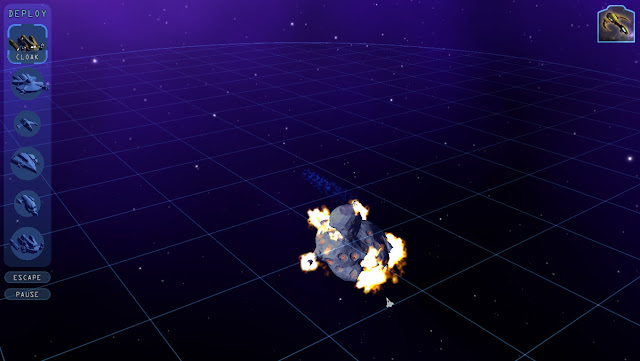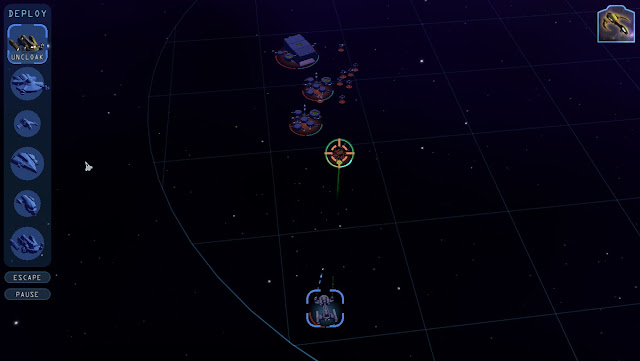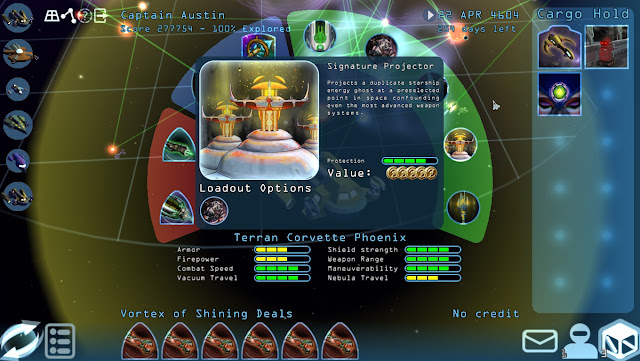Infinite Space Playthroughs: Setting a Record for the Starting Ship Challenge
Recently, I embarked on a challenge run while playing Infinite Space III: Sea Of Stars, one in which I had to avoid trading in my starting capital ship (which can be a Terran Scout, Corvette or Survey Ship) with Enemy Strength and Nebular Density both set to High, for maximum difficulty (and hence points) - in other words, the Starting Ship Challenge. Not only that, I deliberately decided not to have any capital ships larger than a corvette (i.e. frigates and destroyers) at any point in the game, to make things even more challenging. And last but not least, I wanted to earn as many points as I could under these restrictions. It seemed like an impossible task, but I managed to pull it off, so here's how.
As previously stated, the first thing I did was to set both the Enemy Strength and Nebular Density attributes to High at the start of the game - it was the only way to increase the points value of all items, ships, battles, and exploration to their maximum value.
This is the highest difficulty setting in Sea of Stars - which would've made the Phoenix's flight a very short one had I not been prepared.
Early on in this playthrough, I added the Kuti (a Zorg capital ship) and the Bloodfang (a Garthan capital ship to my fleet. Both of them were initially scouts, but I traded them in for corvettes at their factions' respective home systems. Soon, I added Ripcord O'Reilly's customized Terran fighter (which has provision for an interstellar drive) to my fleet, thus filling all but two of the maximum six slots available.
A Garthan corvette is just the ticket for a mercenary who would charge at the opposition head-on. - and it's a worthwhile upgrade over the scout.
Not long after this though, I triggered a quest, something that's guaranteed to happen in every playthrough ever since the game's full public release. This time, it was the Ravian invasion - three fleets of space-faring giant bugs entering from different sides of the map, and if one of those occupies Glory (the Terran home system) for three consecutive years, it's all over. Fortunately, I had a few tricks up my sleeve: a Plasma Coil Cloaker (acquired through random salvage), a Nova Cannon (created from a Timeless Bauble, and used for extreme long-range sniping), and the Kuti's ability to fold space between my fleet's current location and any star system up to two parsecs away (invaluable for shortening travel times, if you can obtain it).
Above, from top: The quest to destroy all three Ravian fleets went smoothly - I didn't lose a single ship, and the fact that I used NPC Tchorak vessels as bait made things even easier. My main quest was finally over, but Captain Austin's Strange Adventure in Infinite Space had only just begun.
With those items and ships at my disposal, eliminating the Ravian presence ended up being surprisingly easy. I could have ended the playthrough right there and then, or even shortly afterwards, but instead chose to stay around and destroy as many hostile NPC fleets as possible within the time limit, while also exploring every single star system on the map.
Above, from top: With the Ravians out of the way, I went on a rampage throughout the sector. finding and destroying every hostile NPC fleet as soon as they spawned, increasing my score even further. It was enough to remind every potential adversary that I was the real master of the Sea of Stars.
To make my task easier, I filled the last two slots in my fleet - first with a Muktian fighter (the Mephit), and later with a second Terran capital ship (the Moon Marauder). Eventually, I traded in all of my scouts for corvettes, and decided to upgrade every single ship (including the Phoenix) as much as my budget could allow, to prepare myself for more challenging encounters later on.
Above, from top: Trading in the last scouts in my fleets for corvettes gave me more room within my fleet for weapons, armor, and equipment, without sacrificing cargo space. However, I deliberately decided not to trade up still further to a frigate or destroyer, to challenge myself further, and also because those ship classes are less well-suited to using speed (and agility) as armor.
Even so, I was a long way from being finished, and carried on waiting, traveling, and attacking as before, in an effort to earn even more points. As soon as a hostile NPC fleet spawned somewhere in the sector, I tracked it down and annihilated it. With the advanced equipment at my disposal, combined with my superior tactical and strategic knowledge, none of the NPCs were a match for my fleet - or more accurately, my flagship, the Phoenix, which ended up being the only ship I deployed in combat during the entire playthrough.
Above, from top: Captain Austin's personal ship, the Phoenix, continued to massacre every hostile fleet it encountered, decloaking to snipe capital ships, before cloaking again and repositioning itself to evade enemy fire - all on its own, while its escorts stood back and watched the fireworks.
Later in the game, I began trading in some Terran Neptunium Railguns for Urluquai Plasma Coil Cloakers, providing a considerable score bonus. By the end of the game, I had vanquished dozens of whole fleets and upgraded every single one of my ships with the most advanced equipment I could find.
Above, from top: The final loadout for my capital ships at the end of the game. With the exception of the Phoenix (which I armed with a Nova Cannon), all of them carried a Multi-Missile Launcher (for long-range bombardment) to complement their Proton Blasters (for short- and medium-range combat).
What made it all the more amazing was the fact that the Phoenix was the only ship I has deployed in combat throughout the game. To make sure of that, I upgraded it with a Signature Projector (for deflecting enemy missiles), a Sardion Optimizer (to increase accuracy and fire rate still further compared to lesser targeting computers - an item shared with the Kuti on this particular playthrough), and a Multibot Repair Drone (for repairing battle damage quickly and efficiently, but not unique to the Phoenix this time around, given that I found a second example of the item, and fitted it to the Kuti). For good measure, I had a Toy Robot in my cargo hold (in the hopes that I could capture Esmerelda upon encountering her, although this sadly never happened this time around), along with an Eye of Babulon (for detecting cloaked ships during combat).
Above, from top: A showcase of some of the unique and advanced equipment I installed on my capital ships during this playthrough.
Other ships in the fleet also had their own unique upgrades: the Kuti's Continuum Renderer Array allowed me to detect every NPC fleet on the map, and the Moon Marauder's Nebular Extent Calculator highlighted all nearby nebular boundaries, as well as providing exact travel time calculations when traveling through a nebula. Finally, each capital ship was fitted with either a Graviton Implosion Drive (which allows for superluminal travel at up to 20 times the speed of light) or a Nebular Ramjet Drive (which propels a fleet at up to 10 times the speed of light in normal space, and twice as fast in a nebula), in addition to a Meson Lattice Shield (the second-strongest shield available, but capable of regenerating to full strength over time, unlike the stronger and more expensive Temporal Flux Shield), and either a Quantum Corkscrew or Ion Impulse Thruster (the former being the second-most effective thruster available, but more affordable than the Reactionless Thruster, and the latter being the fastest thruster that can be purchased at the Terran home system, or any other home system for that matter).
When all was said and done, I had scored 281,051 points - not too far off my personal best of over 300,000 points, and a personal best for any of my playthroughs in which I didn't have a fleet with any capital ship larger than a corvette (in other words, no frigates or destroyers).
Above, from top: After saving Glory from annihilation, exploring the whole of Sector Prime, discovering many lucrative trade routes, and defeating every hostile fleet in the sector, Captain Austin went down in history as, one of the greatest fleet commanders of all time, if not the greatest, and became the next president of the Glory system.
What could I have done differently during this playthrough? Not much, actually, although had I found at least one Temporal Flux Shield, Tachyon Ray Gun, Reactionless Thruster, or Anti-Graviton Shunt (or any combination of these items), I would have installed them on one of my capital ships (and definitely fitted them to the Phoenix in the case of the former two) without hesitation. Also, I could have started my Urluquai trading run even earlier, and continued it until the Urluquai shop was full of Neptunium Railguns, before moving to the Muktian trading route (two Structural Gluon Shields for a single Multi-Missile Launcher) if it had opened up by then (and this one can be exploited indefinitely until the end of the game, unlike the Urluquai Cloaking Device trade run). Either of those actions would have increased my score still further, potentially beyond the 300,000 point threshold (and even setting a new record if I kept on trading for long enough until the time limit), but as it is, I'm happy to score >280,000 points without ever having fielded a single capital ship larger than a corvette during my entire playthrough.
That wraps up my recap of what turned out to be one of my strangest adventures in the entire Infinite Space trilogy. Let's hope that the next one will be even stranger. Until then, see you next time!
















































